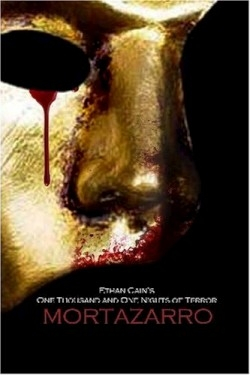
Mortazarro
Ethan Cain's One Thousand and One Nights of Terror
Using Arabian Nights as a template author Ethan Cain delves into the dark world of a character also named Ethan Cain a collector of young women who serve as muses for his fantasies until he tires of them and kills them. Shyla his latest captive keeps his imagination and herself alive by creating a story each night. The more gruesome the tale the better it is liked by her captor.
All Shyla knows about “Ethan Cain” is that he is a writer of horror stories and that his name is a pseudonym; she sees him only disguised by a mask “made of his previous ‘muses.’” Although Shyla recognizes his voice she can’t remember where it was that she had heard it. “But this she knew for certain: She had crossed paths with him” the author writes. “And now she understood more than ever why the books of Ethan Cain were so much darker than the average horror tale. They had come from a place of pure fear from the hearts and minds of hundreds of women who had bought their time with stories…”
Kept in a lightless dungeon filled with smells of rot and decay Shyla tells stories in exchange for her life. The longest of these is “Mortazarro” the tale of an opera that serves as a portal to a dark realm in which lovers are separated captured and enslaved by evil entities that nourish their own foul lives by devouring human hearts. “The Ancient” and “Kannibal Klownz” are shorter than the multiple episodes of Mortazarro and each tells its own tale of carnage and destruction.
Although it would be easy to dismiss this work as motivated by an adolescent fascination with gruesome scenes of pain blood and gore a closer look reveals messages of import. The author asserts that one’s heart is one’s salvation—that keeping the remembrance of love and being loved can carry one through the most desperate of times and that it is important to be aware that love and hate exist in all of us. Cain suggests that when one forgets who one is and the purpose of one’s life it is easy to lose one’s heart and passion and become a slave to someone else’s music.
Questions of a metaphysical nature are also raised: Is what we think of as our life on this planet with all its pain and suffering only an entertainment for invisible eyes on another plane of existence? Is unity only achievable through the destruction of those with whom one disagrees? Why is it that so many people live their lives in fear of something they have been told about by others but never personally experienced? Can or should the “inner beast” of an artist be tamed and what happens when this dark energy is finally released?
It is hoped that the author will continue to pose these questions in a manner less likely to repel those who are seeking answers.
Disclosure: This article is not an endorsement, but a review. The publisher of this book provided free copies of the book and paid a small fee to have their book reviewed by a professional reviewer. Foreword Reviews and Clarion Reviews make no guarantee that the publisher will receive a positive review. Foreword Magazine, Inc. is disclosing this in accordance with the Federal Trade Commission’s 16 CFR, Part 255.
